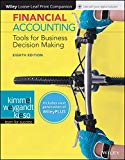
Financial Accounting: Tools for Business Decision Making, 8e WileyPLUS (next generation) + Loose-leaf
8th Edition
ISBN: 9781119491057
Author: Paul D. Kimmel, Jerry J. Weygandt, Donald E. Kieso
Publisher: Wiley (WileyPLUS Products)
expand_more
expand_more
format_list_bulleted
Concept explainers
Question
Chapter 10, Problem 10.12BE
To determine
Long-term liabilities
Long-term liabilities are obligations that the company needs to pay after at least one year or more. Long term liabilities are otherwise called as long-term debt.
To prepare: The long-term liabilities section of the
Expert Solution & Answer
Want to see the full answer?
Check out a sample textbook solution
Students have asked these similar questions
Determine the price of a $1.3 million bond issue under each of the following independent assumptions:
Maturity 10 years, interest paid annually, stated rate 8%, effective (market) rate 10%.
Maturity 10 years, interest paid semiannually, stated rate 8%, effective (market) rate 10%.
Maturity 10 years, interest paid semiannually, stated rate 10%, effective (market) rate 8%.
Maturity 20 years, interest paid semiannually, stated rate 10%, effective (market) rate 8%.
Maturity 20 years, interest paid semiannually, stated rate 10%, effective (market) rate 10%.
If total assets increase while liabilities remain unchanged, equity must:
A) IncreaseB) DecreaseC) Remain the sameD) Be negative
No chatgpt!!
Which of the following is an intangible asset?
A) InventoryB) CopyrightC) EquipmentD) Accounts Receivable
Chapter 10 Solutions
Financial Accounting: Tools for Business Decision Making, 8e WileyPLUS (next generation) + Loose-leaf
Ch. 10 - Prob. 1QCh. 10 - Prob. 2QCh. 10 - Prob. 3QCh. 10 - Prob. 4QCh. 10 - Prob. 5QCh. 10 - (a) Identify three taxes commonly paid by...Ch. 10 - Prob. 7QCh. 10 - Prob. 8QCh. 10 - Contrast these types of bonds: (a) Secured and...Ch. 10 - Prob. 10Q
Ch. 10 - Prob. 11QCh. 10 - Prob. 12QCh. 10 - Prob. 13QCh. 10 - Lee and Jay are discussing how the market price of...Ch. 10 - Prob. 15QCh. 10 - Prob. 16QCh. 10 - Prob. 17QCh. 10 - Prob. 18QCh. 10 - Prob. 19QCh. 10 - Prob. 20QCh. 10 - Prob. 21QCh. 10 - Prob. 22QCh. 10 - Prob. 23QCh. 10 - Prob. 24QCh. 10 - Prob. 25QCh. 10 - Prob. 26QCh. 10 - Prob. 27QCh. 10 - Prob. 28QCh. 10 - Prob. 29QCh. 10 - Prob. 30QCh. 10 - Prob. 31QCh. 10 - Prob. 10.1BECh. 10 - Prob. 10.2BECh. 10 - Prob. 10.3BECh. 10 - Prob. 10.4BECh. 10 - Prob. 10.5BECh. 10 - Prob. 10.6BECh. 10 - Prob. 10.7BECh. 10 - Prob. 10.8BECh. 10 - Prob. 10.9BECh. 10 - Prob. 10.10BECh. 10 - Prob. 10.11BECh. 10 - Prob. 10.12BECh. 10 - Prob. 10.13BECh. 10 - Prob. 10.14BECh. 10 - Prob. 10.15BECh. 10 - Prob. 10.16BECh. 10 - Prob. 10.17BECh. 10 - Prob. 10.18BECh. 10 - Prob. 10.19BECh. 10 - Prob. 10.1ADIECh. 10 - Prob. 10.1BDIECh. 10 - State whether each of the following statements is...Ch. 10 - Prob. 10.3ADIECh. 10 - Prob. 10.3BDIECh. 10 - Prob. 10.4DIECh. 10 - Prob. 10.1ECh. 10 - Prob. 10.2ECh. 10 - Prob. 10.3ECh. 10 - Prob. 10.4ECh. 10 - Prob. 10.5ECh. 10 - Prob. 10.6ECh. 10 - Prob. 10.7ECh. 10 - Prob. 10.8ECh. 10 - Prob. 10.9ECh. 10 - Prob. 10.10ECh. 10 - Prob. 10.11ECh. 10 - Prob. 10.12ECh. 10 - Prob. 10.13ECh. 10 - Prob. 10.14ECh. 10 - Prob. 10.15ECh. 10 - Prob. 10.16ECh. 10 - Prob. 10.17ECh. 10 - Prob. 10.18ECh. 10 - Prob. 10.19ECh. 10 - Prob. 10.20ECh. 10 - Prob. 10.21ECh. 10 - Prob. 10.22ECh. 10 - Prob. 10.23ECh. 10 - Prob. 10.24ECh. 10 - Prob. 10.25ECh. 10 - Prob. 10.1APCh. 10 - Prob. 10.2APCh. 10 - Prob. 10.3APCh. 10 - Prob. 10.4APCh. 10 - Prob. 10.5APCh. 10 - Prob. 10.6APCh. 10 - Prob. 10.7APCh. 10 - Prob. 10.8APCh. 10 - Prob. 10.9APCh. 10 - Prob. 10.10APCh. 10 - Prob. 10.11APCh. 10 - Prob. 10.12APCh. 10 - Prob. 10.13APCh. 10 - Prob. 10.1CACRCh. 10 - Prob. 10.1EYCTCh. 10 - Prob. 10.2EYCTCh. 10 - Prob. 10.3EYCTCh. 10 - Prob. 10.4EYCTCh. 10 - Prob. 10.5EYCTCh. 10 - DECISION-MAKING ACROSS THE ORGANIZATION On January...Ch. 10 - Prob. 10.9EYCTCh. 10 - Prob. 10.10EYCTCh. 10 - Prob. 10.14EYCTCh. 10 - Prob. 10.1IFRSECh. 10 - Prob. 10.2IFRSECh. 10 - Prob. 10.3IFRSECh. 10 - Prob. 10.4IFRSE
Knowledge Booster
Learn more about
Need a deep-dive on the concept behind this application? Look no further. Learn more about this topic, accounting and related others by exploring similar questions and additional content below.Similar questions
- Which of the following is an intangible asset? A) InventoryB) CopyrightC) EquipmentD) Accounts Receivableno aiarrow_forwardWhich of the following is an intangible asset? A) InventoryB) CopyrightC) EquipmentD) Accounts Receivablearrow_forwardWhat does a ledger account represent? A) A detailed record of all business transactionsB) A summary of trial balancesC) An individual record for each accountD) The final balance of a financial statement Need help!arrow_forward
- What is the primary purpose of accounting? A) To generate tax revenueB) To record, summarize, and report financial transactionsC) To determine the market value of assetsD) To manage payrollarrow_forwardWhat are the three main financial statements in accounting?arrow_forwardCan you solve this general accounting question with accurate accounting calculations?arrow_forward
arrow_back_ios
SEE MORE QUESTIONS
arrow_forward_ios
Recommended textbooks for you
- Principles of Accounting Volume 1AccountingISBN:9781947172685Author:OpenStaxPublisher:OpenStax College
 Intermediate Accounting: Reporting And AnalysisAccountingISBN:9781337788281Author:James M. Wahlen, Jefferson P. Jones, Donald PagachPublisher:Cengage Learning
Intermediate Accounting: Reporting And AnalysisAccountingISBN:9781337788281Author:James M. Wahlen, Jefferson P. Jones, Donald PagachPublisher:Cengage Learning

Principles of Accounting Volume 1
Accounting
ISBN:9781947172685
Author:OpenStax
Publisher:OpenStax College

Intermediate Accounting: Reporting And Analysis
Accounting
ISBN:9781337788281
Author:James M. Wahlen, Jefferson P. Jones, Donald Pagach
Publisher:Cengage Learning